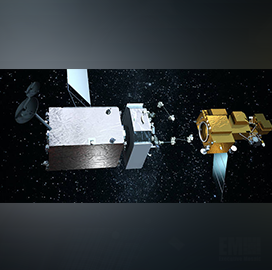NASA has granted Psionic rights to use a light detection and ranging technology that the agency originally developed for use in robotic servicing of a satellite in low-Earth orbit.
Under a signed licensing agreement, the company can further develop and integrate the Kodiak lidar system with similar commercial technologies to support future space missions, NASA said Saturday.
The agency's Goddard Space Flight Center in Maryland designed the technology to generate a 3D image for data collectors to measure the altitude and position of the target’s surface.
Kodiak will function as part of a relative navigation system for the On-orbit Servicing Assembly, and Manufacturing 1 spacecraft on a mission to automatically refuel the government-owned Landsat 7 satellite.
Hampton, Virginia-based Psionic licensed a Doppler lidar technology from NASA's Langley Research Center in 2016.
Related Articles
The U.S. Army’s Communications-Electronics Command Software Engineering Center, or CECOM SEC, and the U.S. Military Academy at West Point have collaborated to evaluate the feasibility of the CECOM SEC-developed mapping between zero trust and the Pentagon’s Risk Management Framework, or RMF. The Army said Thursday the testing sought to collect feedback on the mapping’s application. Zero trust is a modern cybersecurity framework built on the “never trust, always verify” principle. RMF is a systematic structure that authorizes and manages risk in the Department of War’s systems. Helping West Point Enhance Zero Trust Posture According to the Army, the mapping developed
The Federal Acquisition Regulatory Council on Thursday issued new model deviation text for four parts of the FAR as part of the Revolutionary FAR Overhaul, or RFO, initiative. In April, President Donald Trump signed an executive order directing his administration to amend FAR to streamline the federal procurement process and eliminate barriers to doing business with the government. The FAR Council released new text for Part 3 – Improper Business Practices and Personal Conflicts of Interest; Part 17 – Special Contracting Methods; Part 27 – Patents, Data, and Copyrights; and Part 45 – Government Property. These parts are open for
MITRE has released a report highlighting the need for the defense acquisition system, or DAS, to be more warfighter-centric to facilitate the delivery of capabilities that keep pace with the rapidly evolving battlefield conditions. The nonprofit corporation said Friday uniformed engineers and scientists should have sufficient acquisition training and authorities to rapidly innovate and address emerging problems at the tactical edge. Extreme Product Ownership MITRE cited U.S. Special Operations Command’s adoption of “Extreme Product Ownership,” an agile approach that focuses on users and value to reduce risks to development and combat operations. In the report, MITRE mentioned the 160 Special





